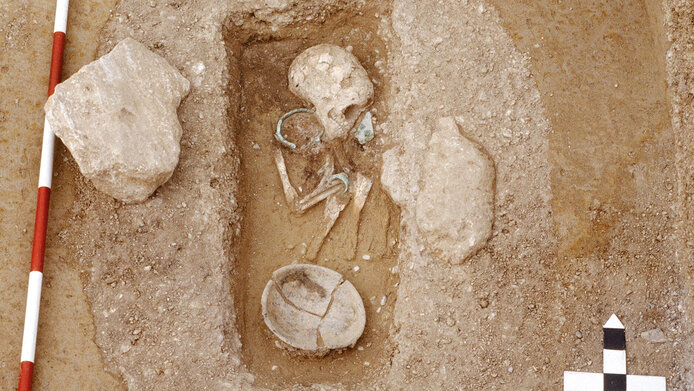Franzhausen's dead reveal Bronze Age gender roles

Franzhausen I and II are two Bronze Age burial sites located in Lower Austria between St. Pölten and Krems in the Traisental valley. In the Early Bronze Age (between 2300 and 1600 BC), over 2,200 people – men, women and children – were buried there. While Franzhausen I has been intensively investigated, Franzhausen II, a larger site with around 1,500 burials, has remained largely unexplored.
“Franzhausen II is a wonderful resource, especially given the many new analytical methods developed in archaeology in recent years,” says Katharina Rebay-Salisbury, Professor of Human Prehistory at the University of Vienna. One of these methods involves the analysis of the protein amelogenin in tooth enamel. As this protein differs in women and men, it is possible to use this molecular biology method to determine the genetic gender. “I had the idea to combine these analyses with research into Franzhausen II, this unexplored gold mine,” notes Rebay-Salisbury. Using the FWF's 1000 Ideas funding scheme for particularly original research projects, Rebay-Salisbur and an interdisciplinary team are now investigating the role of gender in the life of Bronze Age humans.
Katharina Rebay-Salisbury is a professor of human prehistory at the University of Vienna. In addition, she heads the research group “Prehistoric Identities” at the Austrian Archaeological Institute.
The project “Sex-based differences in Bronze Age childcare” receives EUR 150,741 in funding from the Austrian Science Fund FWF and is set to run until the end of 2024.

Bronze Age children
In the Bronze Age, burials were highly gender-specific. Based on gender, cultural practices foresaw different positioning of the deceased in the grave and different grave gifts. By comparing this with biological sex, Rebay-Salisbury can pursue several issues at once. In the past, archeologists were unable to clearly determine the biological sex of children because the skeletal morphology of girls and boys shows no significant differences. Now, however, amelogenin analyses from Franzhausen I confirm that even infants were buried in a gender-specific manner. “This is unusual when compared to other cultures, because infants were usually considered to be part of the mother’s sphere and were therefore assigned to the female realm,” explains Rebay-Salisbury.
Also, the archaeologist wants to use this innovative method to reconstruct the children's lives and investigate whether one of the two sexes was disproportionately affected by malnutrition, trauma, illness or infanticide. Dental wear analyses of 75 children from Franzhausen I already show that children in the Bronze Age tended to receive more solid, abrasive food than children today, and they rarely suffered from tooth decay. There are also indications that girls and boys may have had different access to certain foods such as meat.
Trans identities extremely rare
The gender-specific burials of the Bronze Age included clearly defined practices. Men were buried lying on their left side with their heads to the north and their feet to the south. Women, on the other hand, were laid on their right side and oriented in the opposite direction. In addition, there were gender-specific burial objects such as costumes, jewelry and tools. The depth of the grave also depended on social status and gender: men were usually buried in deeper graves, women in shallower ones, and children were buried in very shallow graves or not at all if beneath the age of two.
These practices served to identify and emphasize the social status of the deceased, explains Rebay-Salisbury. It is interesting to note that not a single case was found in which a woman was buried like a man or vice versa. “In isolated cases we do see mixed burial formats, however. These are currently the most difficult to interpret,” notes Rebay-Salisbury with reference to the initial findings of the project, which are currently being prepared for publication.
Bronze Age gender roles
Bronze Age communities consisted of several hundred people who lived together in villages and used bronze primarily for jewelry and tools. “These people had to be part of well-connected networks in Europe in order to have access to the raw materials and gain the necessary craftsmanship. We also see that occupations such as that of blacksmiths emerged during this period and were predominantly practiced by men,” says Rebay-Salisbury. This explains why gender binarity increased compared to the preceding Neolithic period. In addition, population growth encouraged the division of labor and sharpened the contrasts between the sexes.
“In today's society, gender identity is considered as something that in part we ourselves can define and live by. And this is why the gender issue finds us caught between the poles of how we see ourselves and how we are seen by others,” says Rebay-Salisbury. The graves from Franzhausen reveal how people assessed the gender of their deceased after their death – for it is well-known that the dead cannot bury themselves. With the help of her 1000 Ideas project, Rebay-Salisbury now wants to provide insights into the lives of these people and how the sexes lived together during the Bronze Age.
Publications
Rebay-Salisbury K., Wiltschke-Schrotta K., Berner M., Wolf M., Kanz F.: More Error than Minority: gendered burial practices align with peptide-based sex identification in early Bronze Age burials in Central Europe, Publikation in Vorbereitung, 2024
Bas M., Kurzmann C., Willman J., Pany-Kucera D., Rebay-Salisbury K., Kanz F.: Dental wear and oral pathology among sex determined Early Bronze-Age children from Franzhausen I, Lower Austria, in: PLoS One 2023
Rebay-Salisbury K., Bortel P., Janker L., Bas M. et al.: Gendered burial practices of early Bronze Age children align with peptide-based sex identification: A case study from Franzhausen I, Austria, in: Journal of Archaeological Science 2022





